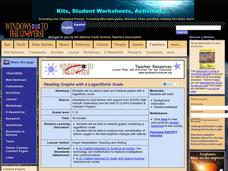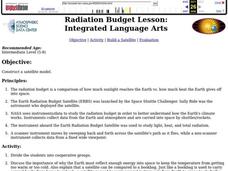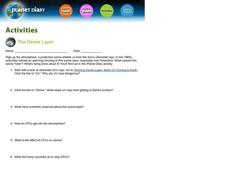Curated OER
Water, Oceans and Atmosphere
There are some really nice diagrams and facts regarding the atmosphere and regulation of energy levels in this PowerPoint. It would be wise to double-check some of the details, but these slides would provide a nice visual recap of...
Curated OER
Evidence of Change Near the Arctic Circle
Students analyze graphs and make conclusions about climate change. In this climates lesson students produce graphs and identify relationships between parameters.
Curated OER
Reading Graphs with a Logarithmic Scale
Guide high school meteorologists through a detailed examination of oxygen concentration data. The learners analyze a line graph containing logarithmic data and employ the use of a graphing calculator. A comprehensive worksheet and links...
Curated OER
Climate Shifts
Eight slides of information related to shifts in the climate make up this presentation. The vocabulary and concepts displayed are geared toward high school meteorology learners. Content is not cohesive from slide to slide, but the...
Curated OER
Gallery Walk Questions on Earth's Radiation Balance
Questions that can be used in a lesson on Earth's radiation balance are suggested in this resource. It is not a lesson plan, per se, but it is a list of questions for stations within a "Gallery Walk" lesson. The link to how Gallery Walks...
Curated OER
UV light & Ozone layer
Middle-school meteorologists absorb information about ultraviolet radiaton and consider the ozone layer. The book that learners are supposed to refer to is not available, so you might want to locate some graphics or posters...
Curated OER
Homemade Barometer
To reinforce the action of air pressure, have your meteorology pupils construct a barometer. They place the barometer into a closed system, a miniature atmosphere if you will, and notice the movement of the needle on the homemade...
Curated OER
Carbon Cycles
Students examine the carbon cycle and how carbon atoms travel through it. In this energy cycles instructional activity students describe how human activities affect the carbon cycle.
Curated OER
Graphing the Temperature within the Atmosphere
Musing meteorologists design graphs of the temperature and pressure changes for altitude increase in our atmosphere. The activity is pertinent to middle school earth science curriculum. Vary the type of homework you assign when teaching...
Curated OER
Interplanetary Travel Guide
In groups of six, middle school space scientists create an imaginative travel brochure for attracting visitors to the planet Mars. Information must include surface features and atmospheric conditions. Although time-consuming, this is a...
Curated OER
Your Own Greenhouse
Young science learners construct a greenhouse out of a plastic bottle. They use a nail to punch a hole through which a thermometer will be inserted to monitor the temperature. This simple experiment easily demonstrates the greenhouse...
US Department of Energy
Sunlight and Evaporation
Here is a simple inquiry experiment designed to demonstrate that the energy from sunlight can evaporate water. Young scientists follow provided procedural steps to construct a model of our atmosphere using a bowl, a cup, water and...
Curated OER
Air Quality Issues
Young scholars identify the different layers of the atmosphere. They examine the different types of air pollutants. They also discover laws in effect that work to protect the environment.
Curated OER
The Ozone
Students engage in lesson concerned with the concept of the ozone layer. They write a reflective journal using prior knowledge. Students read sources of information about the existence of a hole in the ozone layer. Finally they create...
Curated OER
Radiation Budget
Young scholars examine the radiation budget and the launching of the Budget Satellite. They role-play as designers of the satellite and construct one with a power source, instruments, and sensors. they explain how their satellite...
Curated OER
Aerosol Lesson: Science - Graphing SAGE II Data
Young scholars examine and plot atmospheric data on bar graphs.
Curated OER
Stoichiometry (gases and masses)
In this chemistry worksheet, students identify how many liters of oxygen can be consumed to form carbon dioxide. Then they identify how many liters of sulfur dioxide are produced if the gas is at STP.
Curated OER
AMOUNT OF GREENHOUSE GASES IN THE GLOBAL ATMOSPHERE
Students feel the changes of the amounts of greenhouse gases in the global atmosphere. They learn that the amounts of greenhouse gases in the global atmosphere are clearly changing. Some evidences of these changes include levels of...
Curated OER
Weather Lesson 1
Students describe and compare the layers of the atmosphere. They explain how to measure the temperature of the atmosphere. They also explain what causes the atmosphere to heat up in some places more than in others.
Curated OER
Radiation and Controlling Heat Flow
The carbon dioxide in our atmosphere and its effect on how heat is contained is summarized here. The flow of heat is explained with details about insulation and conduction. There are diagrams of heat circulation on a global level and...
Curated OER
Atmosphere and Symbolism in Poetry
Analyzing atmosphere and symbolism by focusing on a well-known poem, The Raven, is the strategy presented to writers in this presentation. Sorrow, darkness, and many other image words are used to help students question and analyze poetry...
Curated OER
The Ozone Layer
In this ozone worksheet students complete an interactive activity on the thinning of the ozone then answer a series of questions on the earths UV rays.
Curated OER
Earth Science: travel
In this earth science worksheet learners complete a series of multiple choice and short answer questions that includes solar radiation, temperature, porosity and rock formations.

























